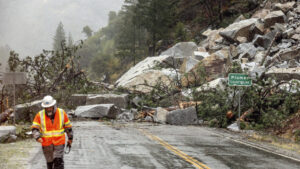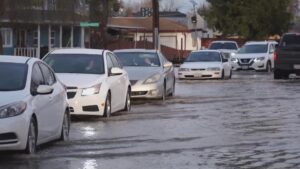
Northern California Flooding? Rain has started to recede across much of California, yet flooding risks remain a significant threat this week. Residents in Soquel remain stranded inside their homes as a manhunt is ongoing for a missing 5-year-old boy who went missing earlier in January.
Some are hoping for an immediate return to normalcy; others are trying to understand what happened and prepare for future storms.
Rainfall
As California enters 2019, its residents have experienced widespread flooding, power outages and mudslides as the wet season kicks into high gear. Since Christmas Eve, several atmospheric river storms have hit California, providing nearly half its annual precipitation totals.
Forecasters report that even though rainfall has subsided in certain areas, forecasters warn of additional flooding risks due to saturated ground conditions. A second storm is due to arrive this weekend with even more precipitation, flood risks and windy conditions.

The new storm will tap an atmospheric river – an air mass stretching from the Pacific Ocean to Sierra Nevada foothills and coast – which could potentially cause major flooding from Santa Cruz County to Monterey Bay, according to National Weather Service forecasts. Additionally, this could create issues related to mudslides or rockslides.
Atmospheric rivers were once responsible for devastating flooding to communities from Bakersfield to San Francisco. But with climate change, intense rainstorms are occurring more frequently and producing greater quantities of rain than before due to warmer air holding on more moisture.
As the rain continues, officials have been working to find ways to manage flood waters most affected areas. Kings and Tulare counties have seen local tug-of-war between farmers and government agencies over how best to manage flooding water in key locations – like Allensworth/Alpaugh where residents are trapped in their homes as floodwaters surge from an adjacent farmer’s property toward them.
Watsonville residents remain calm as sandbags line garage doors and people gather on levee edges to watch roiling waters recede, but some residents have taken to peering out at the rushing waters through windows in their homes while waiting for instructions to evacuate. Some have criticised county officials for encouraging their stay; while others believe the community has come together and is prepared for whatever comes next.
Northern California Flooding: Snowmelt
Flood concerns in California foothill and valley communities due to massive snowpack accumulation from recent storms have raised serious flooding concerns this winter, but cooler weather systems have helped moderate melting processes while keeping river and stream levels manageable. A warm atmospheric river is forecasted to sweep across the state next week bringing additional rain and snowfall for many areas already saturated by moisture.
Atmospheric rivers are narrow bands of moisture that transport moisture across thousands of miles until discharging into rain or snowfall, according to National Oceanic and Atmospheric Administration data. Climate change makes atmospheric rivers even more frequent in Western regions, increasing their ability to transport massive quantities of moisture over long distances, according to NOAA reports.
Later this week, another storm system will arrive, amplifying an atmospheric river which has already saturated much of Northern California and much of the Sierra Nevada, prompting flood watches in various locations across both regions. Rain and snowmelt will contribute to rising waters in rivers, creeks and streams.
Flood risks in the foothills of southern Sierra are high due to heavy rainfall and snowmelt; while flooding risks should subside on higher elevations.
An important factor that could influence mountain flooding is whether the sun shines during this period. Solar radiation has an enormous influence on melting snow when temperatures fall below freezing; this year has been particularly mild, however, as cloud cover has reduced direct solar radiation and limited significant melting.
Even when snowmelt occurs slowly, rivers and streams cannot cope. That’s why flood watches remain in effect for lower Sierra areas where mountain streams and gullies are steep and swift, as well as areas prone to soot, ash and other debris which darken snowpack and accelerate its melting.
Rivers and Creeks
Last week’s storm in Northern California dumped heavy rainfall, creating flooding conditions along creeks and rivers and raising levels to dangerously high levels in many places across California. Flood watches have been issued for numerous regions in response.
Rainfall is melting the mountain snowpack and raising rivers and streams, leading to flooding threats along with dams and levees that threaten them.
Rivers are powerful natural forces that can quickly turn fatal during flooding events, threatening property and life alike. To avoid potential tragedies this Memorial Day weekend, public safety officials advise residents to avoid river and creek areas altogether.
Floodwaters in California are caused by rain and melting snow, with shallow floods receding slowly while others can rapidly arise and surge downstream. Depth and velocity are determined by topography and geology in a region, as well as rainfall intensity.
Floodwaters have put pressure on already overtaxed flood control infrastructure. Swollen rivers have affected roads, railroad tracks and power lines while their surge has knocked down trees and destroyed homes.
Floodwaters have forced many from their homes, while also helping replenish drought-stricken reservoirs and mountain snowpacks. Yet snowmelt presents new dangers as waters overflow their banks, threatening to wash away everything in its path.
Monterey County residents were forced to flee their homes this week as the Pajaro River reached an unprecedented record level, forcing dozens to be evacuated after its levee failed. Residents were forced to relocate, forcing 74-year-old levee to breach and forcing residents out.
As part of their response to flooding, state emergency officials are working closely with local officials and emergency management personnel to identify any toxic hazards that could contaminate farmland and waterways, strengthen levees and canals as necessary and raise roads – in addition to helping area communities prepare for evacuations in advance.
Evacuations
After days of flooding, residents in one small community are bussed to an emergency shelter established at its fairgrounds. It’s not the first time; atmospheric rivers bring torrential rainfall or snowfall directly onto low-lying areas in multiple states across the US – creating flooding which has overtopped rivers, broken levees and disrupted traffic systems across states.
On Saturday afternoon, California’s weather forecasting system upgraded from moderate to extreme the risk of flooding across a large swath of central Sierra Nevada and coastal foothills. A state of emergency was already declared in 34 counties including Sacramento and San Francisco cities; federal authorities may declare disasters in many of them as well.
This latest storm system is forecast to bring heavy rainfall and winds to the Sierra Nevada mountains by Monday, with an avalanche threat in Yosemite National Park a distinct possibility. Tuolumne and Merced rivers running through Yosemite could reach or even surpass their flood stage of 10 feet this weekend, potentially leading to major river flooding that cuts off roadways and places homes at risk.
Flood warnings notify those living near swollen rivers to prepare to evacuate. A variety of factors are taken into consideration before issuing evacuation orders, including forecasted river crest height and release from upstream dams; how frequently the river has reached flood stage in past; and whether dam releases could contribute.
Floodwaters have taken hold in several communities within Watsonville, California’s low-lying city, threatening several neighborhoods with evacuation warnings issued to residents living near Glanville Tract, Franklin Pond and Pajaro on the border between Santa Cruz and Monterey Counties – as well as being present along Corralitos and Salsipuedes Creeks which could potentially flood.
Northern California Flooding

